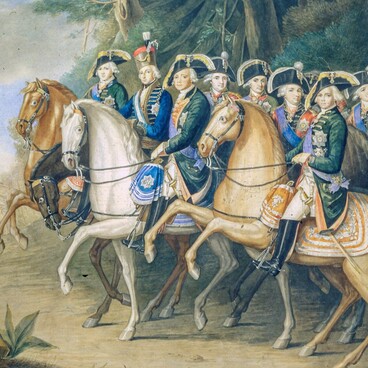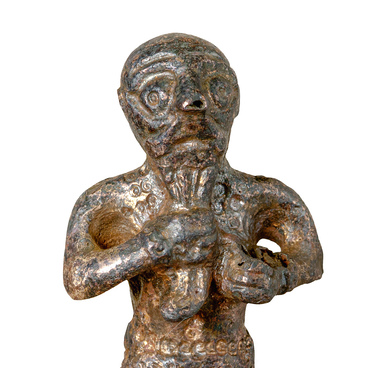The icon of the Mother of God “Our Lady of the Sign” was created by an unknown icon painter in the first quarter of the 18th century. As a sign of respect for the image and in order to protect it from moisture and sunlight, the pictorial image was placed in a precious riza (a metal icon cover) made of silver with gilding. It covers almost the entire surface of the icon: only the faces and hands of the Mother of God and the Child are visible, as well as the faces and figures of the saints, depicted in the margins. The riza is decorated with inserts of colored enamel and precious stones: amethyst, almandine, pearls, quartz.
The upper and lower margins of the riza are filled with embossed floral ornaments. On each side of the main image there are figures of the saints — the great martyrs George and Jacob the Persian, the Saint Onuphrius of Egypt and the Saint Macarius the Roman.
The icon belonged to Alexander Menshikov — a statesman of the 18th century, a favorite and associate of Peter the Great, the de facto ruler of Russia under Catherine the Great. At the end of the 1720s, as a result of court intrigues, Menshikov was accused of corruption and embezzlement of public funds, arrested, deprived of awards, titles and property, and then he was exiled with his family to Siberia, to the city of Beryozov. Shortly before his death, Alexander Menshikov blessed his son Alexander with this icon. This is evidenced by the inscription on a metal plaque: “This image, dying Prince Alexander Danilovich Menshikov used to bless his son, Prince Alexander Alexandrovich Menshikov, in the year of 1729, on… November.” The date is illegible — it could be “3” or “10” November.
The icon that belonged to Menshikov is an exact copy of the ancient icon “Our Lady of the Sign”. According to the legend, it helped to raise the enemy siege of Novgorod in 1170. The city was then surrounded by the troops of the Suzdal Prince Andrey Bogolyubsky, who wanted to punish the Novgorodians for the illegal collection of tribute. The legend states that the Mother of God appeared in a dream of the archbishop and ordered to carry her image to the city wall. When an enemy arrow hit the icon, the Mother of God allegedly started crying. This scene terrified the Suzdal warriors, and they fled. In memory of this event in the 12th century, Archbishop John established a holiday in honor of the icon “Our Lady of the Sign”. The Russian Orthodox Church still celebrates it on November 27.
The upper and lower margins of the riza are filled with embossed floral ornaments. On each side of the main image there are figures of the saints — the great martyrs George and Jacob the Persian, the Saint Onuphrius of Egypt and the Saint Macarius the Roman.
The icon belonged to Alexander Menshikov — a statesman of the 18th century, a favorite and associate of Peter the Great, the de facto ruler of Russia under Catherine the Great. At the end of the 1720s, as a result of court intrigues, Menshikov was accused of corruption and embezzlement of public funds, arrested, deprived of awards, titles and property, and then he was exiled with his family to Siberia, to the city of Beryozov. Shortly before his death, Alexander Menshikov blessed his son Alexander with this icon. This is evidenced by the inscription on a metal plaque: “This image, dying Prince Alexander Danilovich Menshikov used to bless his son, Prince Alexander Alexandrovich Menshikov, in the year of 1729, on… November.” The date is illegible — it could be “3” or “10” November.
The icon that belonged to Menshikov is an exact copy of the ancient icon “Our Lady of the Sign”. According to the legend, it helped to raise the enemy siege of Novgorod in 1170. The city was then surrounded by the troops of the Suzdal Prince Andrey Bogolyubsky, who wanted to punish the Novgorodians for the illegal collection of tribute. The legend states that the Mother of God appeared in a dream of the archbishop and ordered to carry her image to the city wall. When an enemy arrow hit the icon, the Mother of God allegedly started crying. This scene terrified the Suzdal warriors, and they fled. In memory of this event in the 12th century, Archbishop John established a holiday in honor of the icon “Our Lady of the Sign”. The Russian Orthodox Church still celebrates it on November 27.



